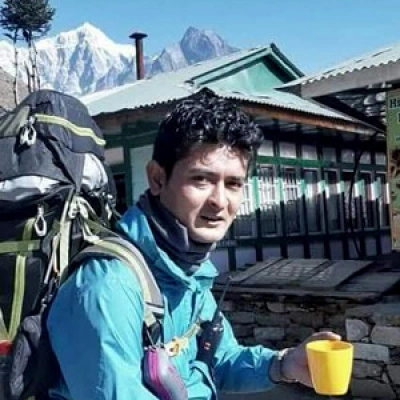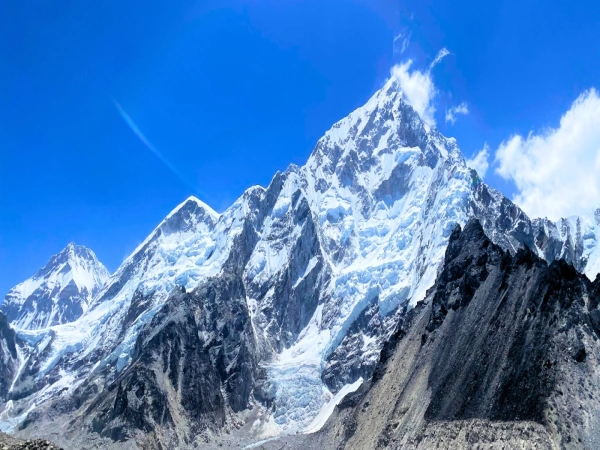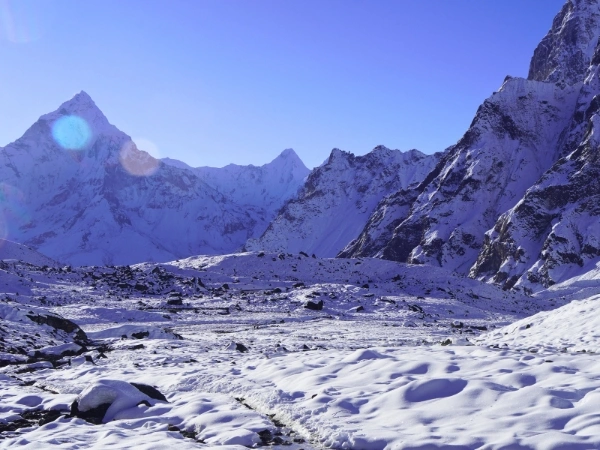Lobuche peak among the popular climbing peaks in Nepal. The Lobuche climb itself is an extension of the Everest Base Camp Trek. Lobuche has many small summits. However, Lobuche has two major peaks, Lobuche East (6119 m), and Lobuche West (6145 m).
Climbing ‘Lobuche Peak’ means climbing the Lobuche east, 6119m. Climbers prefer the south ridge route to reach the Lobuche East. Whereas, Lobuche West is a difficult peak for a climb.
Lobuche climb is a special and technically challenging than the Island peak climb. However, the enchanting panoramic view from the summit is worth your efforts. Lobuche summit curtains the silvery display of Mt. Lhotse, Pumori, Nuptse, Makalu, Ama Dablam, etc. From there, you will also catch a fabulous view of Mt. Everest.
Lobuche Peak Climb is a genuine mountaineering experience. The safe and successful expedition to the peak requires general knowledge of climbing techniques and guide reviews.
Lobuche peak climb takes us through higher altitudes into the Himalayas. So, there are many risks of altitude problems. And, proper acclimatization is the key to a successful climb. So, do not hesitate to spend extra days for rest.
For this trip, you walk through joyful trail and diverse forests into the Sherpa settlements. You can also visit some monasteries. The splendid views of the mountains in Khumbu region are rejoicing.
Lobuche village, a beautiful Sherpa village, is the gateway for Lobuche Peak Climb. The steep and rocky ascend from the Lobuche village gets us to the Lobuche Base Camp, 4950m. The Base Camp is a perfect spot and viewpoint of several peaks including Amadablam, Cholaste, Thamserku, Kantega, and Tawache.
Enjoy a constant and speedy climb from the base camp. You are now at the High Camp. The ascend from the high camp is highly challenging. You will come across steep stone slabs covered with slippery ice or snow.
You must climb 50m on a 45-degree snow wall using fixed lines to reach the proper summit ridge. Now, you'll come across the sharp snowy ridge to the first summit. On the way to the true summit, there is a descent before the final sharp ascent.
Finally, you are at the Lobuche Summit. From there, you can enjoy the heavenly view of the highest mountains in the world.
Difficulties during Lobuche Peak climb
- The ascending trail from Lobuche village is highly steep and rocky. Thus, the walk up to the Lobuche Base Camp is tiresome.
- Lobuche East Peak climbing usually requires 5-6 hours of walking every day. But on the day of the summit, you need to walk for 8-10 hours.
- The steep stone terraces and snowy slopes above the base camp are hard to climb. For this climb, you must learn the use of ropes.
- High Camp, 5600 m awaits you beyond the slippery iced or snowed stones. The stone slabs are too steep and risky as well.
- The 45-degree snow wall climb before reaching the summit ridge is challenging. We use fixed lines. A 50 m ascend through the wall is a much risk.
Are you planning your Lobuche Peak Climbing? Don't hesitate to contact us. Tell us your requirements, we can help you to make your trip memorable.
Physical Condition & Experiences for Lobuche Climbing
Climbing Lobuche East does not demand any kinds of previous climbing experiences. But previous experiences of rock climbing and high altitude trekking is a bonus. This will simplify your climb.
Pre-ice climbing training is also essential. You must learn to use the climbing equipment such as ropes, ice pick, harness, and crampons.
Prepare your body for the walk over rugged hills, steep stones, and tough mountain walks. We advise you regular jogging or walking (10-12 km) per day for 2-3 months before your trip starts.
Plus, we organize pre-climbing sessions before the actual ascent to the summit. There you will get enough training on using ropes, ice axe, crampons, and learn the skill of snow climbings.
For a successful climb, your stamina, willpower, physical fitness, and adaptational characteristics play a vital role. You must walk for 5-6 hours while preparing for the trip. On the summit day of the Lobuche East Climb means a walk of 8-10 hours. Do not feel tired, keep energizing yourself. And the climb ahead is easy and exciting.
If you have pre-existing serious respiratory and chronical illness, it is better that you keep aside the idea of Lobuche peak climb. Anyone must consult their personal medical adviser before the climb.
Best Time for Lobuche Peak Climbing
Autumn and Spring are the best time for treks and climbs in the Nepalese Himalayas. You will get the best of this trip during this time.
The dry, most stable and favorable weather conditions add ease to the trek/ climb. Some people attempt the climb during winter also. However, choosing the snowy winter you are adding risks to your climb.
The higher precipitation and unbearable cold reduce the percentage of a successful climb. Can you afford to risk your life? If not, choose the right time before you go, especially, if you are a novice climber.
Weather conditions during Lobuche Peak Climb
In the Everest region, the weather during spring and autumn means the most stable weather. Spring is the time when the forests cover in an aroma of Rhododendron blossoms. Autumn is the seasons of festivals in Nepal and has perfect weather for the climb.
Rainy season indicates wild forest bushes, slippery trails, and more insects and bugs including leeches. Also, heavy rainfalls may block your scenic views. They can interrupt your climb by bringing more snow during the summit climb.
Winter is very cold. The cold nights and early mornings are very hard to cope with. You will need extra clothes and backpacks to keep you warm. Winter brings thick snow piles on the Lobuche peak. More the snow piles and snowfalls, the more risk is the climb.
Temperatures during Lobuche Peak Climb
Early mornings and late nights are never too warm in the Himalayas. You will need a warm gear for this time while traveling at any time of the year.
In Autumn the average temperature at Lobuche remains around - 5-degree Celsius. While in Spring it is around - 2-degree Celsius. In winter it is around -9-degree Celsius wheres in Summer it is around 5-degree Celsius.
Temperatures at the lower altitudes are a bit warmer. The more you ascend towards higher altitudes, you'll feel gradually descending temperature.
Accommodationand Meals
Accommodation
There are many teahouses during trekking areas (lower altitudes). But their number becomes lesser with your ascent. Till you reach the Lobuche Base Camp, you may stay at the teahouses.
After you start your climb from the base camp, you will be camping in tents. Bring warm sleeping bags and foam mattress for tent accommodation. Also, you must be cautious to maintain your safety and personal hygiene during the climb.
There are several teahouses where you cannot get a single room accommodation. Expect to share your room in twin basis after you startup from Namche Bazaar. During the peak season, you'll have difficulty in finding a room. Most of the teahouses are already booked before are there. So, early booking is a good idea.
Meals
You will have numerous options for food in the Everest region. There are many tea houses in your service. Enjoy typical Nepali food, local foods, and different ethnic and international cuisines during your trek. Three meals a day is fine to boost you for the walk.
Up to the Lobuche base camp, you can have food in the teahouses where you are staying. While you are staying in the tents above the base camp, our cooks will prepare you hygienic food.
Are you planning your Lobuche Peak Climbing? Don't hesitate to contact us. Tell us your requirements, we can help you to make your trip memorable.
Essential Gear for Lobuche Peak Climbing
It is what gears and equipment you take along during your trip that determines how difficult it is going to be. For Lobuche Peak climbing too you must be careful while packing your bags. Along with your packing lists for the trip, you must carry extra mountaineering gears. They include
- Climbing helmet
- Climbing boot
- Crampons
- Climbing harness
- Ascending device
- Descending device
- Ice axe
- Carabiners
- Prusik loop
- Tape sling
- Gloves
- Down jackets
- Waterproof jackets and trousers
- Sunglasses
These are a must for your successful climbing and descends to the summit. And, to use these equipment we give training before the trip as well as during the expeditions.
Tips for Lobuche Peak Climbing
- Do not forget to pack medicines that you may require during the trip.
- Acclimatize properly. Do not rush for the summit.
- Drink plenty of water. Hydration is a key for successful climbing.
- Do not forget to pre-book for the room and food in the lower altitudes if you are traveling during the peak season.
- Inform your guides if, in case, you feel some signs of altitude sickness.
- Take proper training and technical skills before the trip.
- Come physically as well as mentally prepared for any unexpected happenings.
Last Say
Lobuche Peak Climbing is an exciting yet difficult adventure in the Everest region. You must be extra careful and prepared for the technical difficulties, geographical challenges and the possible difficulties.
For any information on this trek, you can contact us. We are happy to address your queries.




